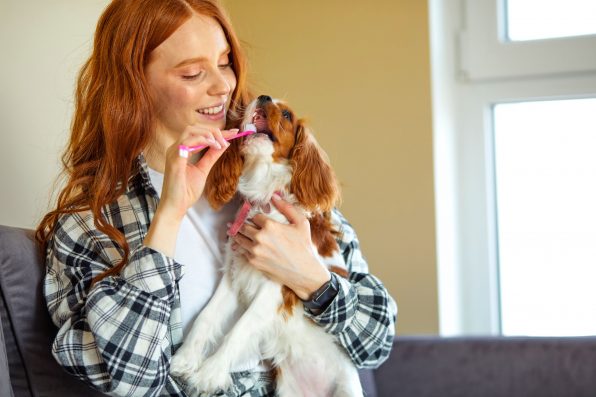You Should Be Brushing Your Dog’s Teeth At Least Two To Three Times Per Week: Here’s How

Dog parents nowadays are more dedicated than ever. You might buy top-of-the-line food for your pup, take them on lengthy walks, and even have their medical care covered by pet insurance.
However, there is still one aspect of canine care that’s often overlooked: the importance of brushing their teeth.
According to research conducted by Petco, 61% of dog owners claimed they never brush their pup’s teeth. Yet, other studies have shown that between 80% and 90% of canines have dental disease at 3 years of age or older.
Dental disease can result in swollen, painful gums and tooth loss. If it’s left untreated, severe periodontal disease may even lead to other health issues, such as liver, kidney, and heart damage.
So, to protect the health of your pup, here’s everything you need to know about brushing your dog’s teeth.
Doggy Dental Care
You may not realize that, just like us humans, the number of bacteria in a canine’s mouth actually doubles every six to eight hours. That’s why daily brushing is optimal.
For some pet parents, though, this is not very realistic. So, you should aim to brush your dog’s teeth at least two to three times per week. And on the days when you don’t brush, you can give your pup a dental treat, use an additive in their water, or rely on a dental wipe.
If you’ve never brushed any canine’s teeth before, the thought might be intimidating. The key to making the process as simple as possible is getting the right tools for the job.

Roman – stock.adobe.com – illustrative purposes only, not the actual person or dog
Never use human toothpaste, as it can upset your dog’s stomach or even be toxic. Instead, invest in some pet-safe toothpaste, as well as a pet-friendly toothbrush.
Dog toothbrushes often have softer bristles and are smaller than a human toothbrush. Larger dogs respond better to brushes with bigger handles, as you’ll be able to reach their back teeth more easily.
Or, if you have a pup on the tinier side, you can look into pet toothbrushes that fit on the end of your finger. This can make entering and maneuvering their mouth much smoother.
Then, once you have the appropriate tools, it’s time to familiarize your dog with the process. You can start by lifting up their lips and providing them with a treat for good behavior. Afterward, begin rubbing either a dental wipe or your finger along their gum line. This will help your pet become accustomed to the sensation.
Toothbrushing will become much more painless if your dog is comfortable with these exercises. So, don’t rush the process.
Finally, when it comes time to brush their teeth, how you hold your pup can make or break the process. Don’t be alarmed if your pet starts to squirm, as this is a very common response.
Rather, be prepared to get your dog in a firm yet comfortable position. For smaller pups, you can wrap them in a towel or sit beside them on a couch. Then, wrap your arm around their body, hold them close to your side, and keep them still as you brush with your other arm.
For larger canines, you can sit beside them on the floor, wrap your arm around their head, and support their chin. With this setup, you can brush with your other arm and use your supporting hand to help move your dog’s mouth.
You don’t need to open your dog’s mouth completely, either. Just lift up their lips and focus on the gum line. Also, keep in mind that plaque and tartar tend to build up on their back teeth, so it’s best to start there.
Use small, circular motions as you brush, with a pressure that’s not too hard or too soft. The more time you spend brushing, the more plaque you will remove. If your dog becomes visibly uncomfortable or upset at any point throughout this process, don’t force them to stay put. This may just create negative associations and make tooth brushing even tougher in the future.
Simply try again later, and over time, your pet should become more tolerant of their new dental care routine.
Sign up for Chip Chick’s newsletter and get stories like this delivered to your inbox.
More About:Animals